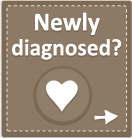
What is SMA?
What are some possible warning signs of SMA in infants?
Some things to watch out for include general weakness, floppiness or hypotonia, delayed or limited movement, difficulty eating or swallowing, lack of reflexes, twitching tongue, and impaired breathing. A blood test for the SMN1 gene is typically required to properly diagnose SMA.
Could YOU be a carrier of SMA?
YES! Click here to learn more.
What is the biggest concern for people with SMA?
Generally, the top concern for most people with SMA is breathing problems, such as pneumonia, respiratory syncytial virus (RSV), lung collapse, or an inability to breathe deeply enough.
What causes respiratory or breathing problems in SMA?
The short answer is muscle weakness. One of the main symptoms of SMA is profound muscle weakness throughout the body. The weakness can cause breathing weakness, coughing weakness, swallowing difficulties, and other problems. Getting food, mucus, or other things in the lungs can lead to pneumonia.
What causes profound muscle weakness in SMA?
The short answer is defective spinal motor neurons. The muscles are weak due to lack of use. The muscles are not used because signals from the brain are not properly sent to the muscles through spinal motor neuron cells.
What causes defective motor neurons in SMA?
The short answer is lack of SMN protein. To function properly, motor neurons depend on a special protein called survival motor neuron protein (SMN protein). The SMN protein levels are not sufficient in people with SMA.
What causes a lack of sufficient SMN protein levels in SMA?
The short answer is a lack of working copies of the SMN1 gene. The primary gene responsible for causing the body to produce SMN protein is called the SMN1 gene. An average person has TWO working copies of the SMN1 gene. A person with only ONE working copy of the SMN1 gene is a “carrier” of SMA, but carriers have enough SMN protein to avoid symptoms of SMA. People with SMA have ZERO working copies of the SMN1 gene and, thus, have insufficient levels of SMN protein.
What causes a lack of working SMN1 genes in SMA?
This the root cause of SMA. An SMN1 gene can be deleted (missing) from the genetic code or it can be mutated to the point that is does not work.
What are the different types of SMA?
What are the basic philosophies of care in SMA?
- Palliative care generally means providing as much love, comfort, and support as possible while refraining from providing much or any respiratory support.
- Non-invasive ventilation (NIV) means using a machine to provide respiratory support via a facial breathing mask, without invading or penetrating the body, such as a bipap machine.
- Invasive ventilation means providing mechanical respiratory support via an invasive procedure such as a tracheostomy (“trach”).
It has been our experience that physicians talking to newly diagnosed families too often do not give families an accurate picture of all of the care options available. Many physicians tell families there is nothing they can do but take their child home and love them. In many cases, this is false. Although there is nothing available to treat or cure SMA, families have many options available to manage SMA.
Many physicians tell newly diagnosed families that their child will be constantly sick and miserable. This is often false. Many SMA children, including those with SMA Type 1, are living longer, healthier, and happy lives thanks to basic SMA protocols developed in the past couple of decades to manage SMA.
Many physicians tell families the only option is to let their child go if sick. This too may be false.
Many physicians tell families their child needs a tracheotomy. This may be true, but often is not.
A physician may tell newly diagnosed families these things either because he or she is unaware of current SMA protocol and advances and the many happily thriving children using them; or (2) the physician is injecting his or her ethics into the situation by withholding critical information and choices from families instead of putting all the options on the table with accurate information and allowing families to make THEIR OWN fully informed choices for their children based upon the family’s own ethics.
A family should make timely and fully informed choices, and those choices should be respected.
YOU MAY HAVE OPTIONS. Please contact us for help.
How do SMA kids with swallowing problems eat safely?
An SMA child who expects or has swallowing difficulty may consider surgical placement of a gastronomy tube (G-tube), a small plastic tube with a cap that goes through the abdominal wall and into the stomach. An alternative to the G-tube is a gastrostomy-jejunostomy tube (GJ-tube) which empties into the intestine instead of into the stomach. GJ-tubes are typically used only if G-tubes are ineffective. Potential G-tube or GJ-tube placement should be considered very soon after diagnosis because as time goes on, surgery becomes more risky as the child loses strength due to the degenerative nature of SMA. If feeding difficulties arise before surgery can occur, then tube feeding may be accomplished with a temporary nasogastric tube (NG-tube), which is placed through the nose and into the stomach.
We generally discourage swallow studies due to the risk of swallowing barium into the lungs (aspirating) during the study. We also generally recommend getting a preventative Nissen fundoplication as part of G-tube pleacement. We also recommend looking in our SMA Library for critical care protocols to be sued during illness or surgery.
What’s the risk of reflux in SMA?
Reflux is fairly common in SMA and there is a risk of pneumonia if reflux is present. There are different methods to manage reflux, such as positioning and medication. Another method is Nissen fundoplication surgery: a surgical procedure where the upper part of the stomach is wrapped around the base of the esophagus. If it is being done, Nissen surgery is usually done early and at the same time as G-tube placement because undergoing surgery itself can be risky with a weak child.
What are some basic medical equipment needs typical for a weaker SMA child?
- Cough assist machine to simulate a cough to get junk out of the airways
- Suction machine to suction saliva and junk out of the nose and mouth
- Bipap machine and connected humidifier to give breathing support during sleep or as needed;
- Pulse oximeter to constantly monitor heart rate and blood oxygen levels
- Rubber percussor or percussive vest to loosen secretions in the airways
- Stethoscope to listen for clear airways
- Thermometer to check frequently for fever
- Nebulizer to blow saline solutionor medication into the airways to loosen up any junk
- Feeding pump to feed via her G-tube or GJ-tube.
- Medical stroller to allow lying flat in transport
- Car bed to allow laying flat in a car
- Ambu bag and oxygen tank for emergency use.
The information provided here is informational only and is not medical advice. Please consult your physician for more information and medical advice specific to your case; each case is different.











